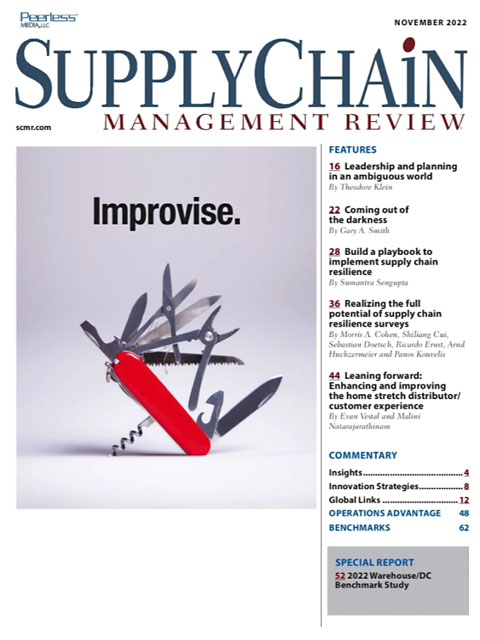Sorry, but your login has failed. Please recheck your login information and resubmit. If your subscription has expired, renew here.
November 2022
Are you resilient? It’s not an idle question. If there’s one word that I’ve heard at every supply chain event I’ve attended this year, its resilience. It is, of course, in response to the last few years in supply chain management. I think its fair to say that supply chains have been knocked to the canvas more times than Rocky. What has become clear as we do our post-pandemic reviews is that the firms that demonstrated the ability to get up off the canvas and keep punching were those that invested in resiliency before the pandemic—even if they didn’t use that term. Browse this issue archive.Need Help? Contact customer service 847-559-7581 More options
B2B businesses, those that we’ll define as distributors for the purposes of this article, have been focusing on developing leaner, agile and efficient operations and business processes to provide their customers with the best product and service. However, in recent years, especially with the onset of omni-channel and e-commerce, it has become more critical for B2B businesses to lean forward to speed up digital adoption in order to integrate, assimilate and share information to provide an enhanced customer experience.
Distributors have always been known for putting the customer at the heart of their businesses. Anything other than servicing the customer has always been secondary. They are continuously focused on improving sales and supply chain processes internally.
For example, distributors have aligned with manufacturers in programs that streamline the introduction of new products, including the sale of items on consignment from the manufacturer. Distributors are also innovative in their ability to provide local service (even at the customer’s worksite), push weekly or bi-weekly delivery to same or next-day delivery, use innovative methods to track items within an order to ensure accuracy and quality for the recipient and to enhance the internal and external supply chain to maximize the customer experience.

This complete article is available to subscribers only.
Log in now for full access or start your PLUS+ subscription for instant access.
SC
MR
Sorry, but your login has failed. Please recheck your login information and resubmit. If your subscription has expired, renew here.
November 2022
Are you resilient? It’s not an idle question. If there’s one word that I’ve heard at every supply chain event I’ve attended this year, its resilience. It is, of course, in response to the last few years in… Browse this issue archive. Access your online digital edition. Download a PDF file of the November 2022 issue.B2B businesses, those that we’ll define as distributors for the purposes of this article, have been focusing on developing leaner, agile and efficient operations and business processes to provide their customers with the best product and service. However, in recent years, especially with the onset of omni-channel and e-commerce, it has become more critical for B2B businesses to lean forward to speed up digital adoption in order to integrate, assimilate and share information to provide an enhanced customer experience.
Distributors have always been known for putting the customer at the heart of their businesses. Anything other than servicing the customer has always been secondary. They are continuously focused on improving sales and supply chain processes internally.
For example, distributors have aligned with manufacturers in programs that streamline the introduction of new products, including the sale of items on consignment from the manufacturer. Distributors are also innovative in their ability to provide local service (even at the customer’s worksite), push weekly or bi-weekly delivery to same or next-day delivery, use innovative methods to track items within an order to ensure accuracy and quality for the recipient and to enhance the internal and external supply chain to maximize the customer experience.
SC
MR


Latest Supply Chain News
- Retail sales see gains in October, reports Commerce and NRF
- Balancing green and speed: Home delivery insights from the pandemic era
- AdventHealth named top healthcare supply chain by Gartner
- Geopolitical readiness in supply chains: Strategic challenges for leaders
- Unlocking retention: The role employee engagement plays
- More News
Latest Podcast

 Explore
Explore
Procurement & Sourcing News
- Retail sales see gains in October, reports Commerce and NRF
- Geopolitical readiness in supply chains: Strategic challenges for leaders
- With capacity to spare, logistics real estate demand remains subdued
- Tariffs, taxes and trade: The impact of Trump’s reelection on the supply chain
- How to improve demand forecasts for new product families
- Aggregators sitting on the throne of Africa’s e-commerce supply chains: What lessons can we learn?
- More Procurement & Sourcing
Latest Procurement & Sourcing Resources

Subscribe

Supply Chain Management Review delivers the best industry content.

Editors’ Picks





